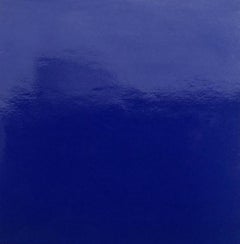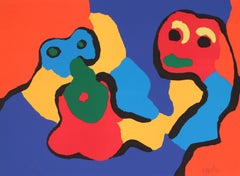Cozette de Charmoy Art
to
2
2
2
2
Battlefield List - Handsigned Screen Print
By Cozette de Charmoy
Located in Paris, FR
Cozette de CHARMOY (1939-)
Battlefield List
Screen Print
Handsigned in pencil
Limited to 75 copies and a few EA (here an EA proof)
On Arches vellum 88 x 60 cm (c. 35 x 24 inch)
Exc...
Category
1990s Modern Cozette de Charmoy Art
Materials
Screen
In the Blur of Numbers - Handsigned Screen Print
By Cozette de Charmoy
Located in Paris, FR
Cozette de CHARMOY (1939-)
In the Blur of Numbers
Screen Print
Handsigned in pencil
Limited to 75 copies and a few EA (here an EA proof)
On Arches vellum 88 x 60 cm (c. 35 x 24 inch...
Category
1990s Modern Cozette de Charmoy Art
Materials
Screen
Related Items
La Conférence à la Sorbonne, 3 Juin, 1959, Lt Ed Silkscreen cover record albums
By Yves Klein
Located in New York, NY
Yves Klein
La Conférence à la Sorbonne, 3 Juin, 1959, 1959-1963
Two 12-inch vinyl records held in gatefold sleeve with silkscreen cover jacket in IKB International Klein Blue...
Category
1960s Modern Cozette de Charmoy Art
Materials
Plastic, Mixed Media, Screen, Offset, Pencil, Board, Lithograph
No Reserve
H 12.7 in W 12.7 in D 2 in
Some People Together
By Karel Appel
Located in New York, NY
Some People Together, 1974
Hand-signed and dated in pencil
Color lithograph and screenprint
Sheet 22 x 29 3/4 inches; 559 x 756 mm.
Edition 110
Category
1970s Modern Cozette de Charmoy Art
Materials
Lithograph, Screen
Some People Together
By Karel Appel
Located in New York, NY
Some People Together, 1974
Hand-signed and dated in pencil
Color lithograph and screenprint
Sheet 22 x 29 3/4 inches; 559 x 756 mm.
Edition 110
Category
1970s Modern Cozette de Charmoy Art
Materials
Lithograph, Screen
"Indianapolis Museum of Art Inaugural Exhibitions", Color Silkscreen, Signed
By Robert Indiana
Located in Detroit, MI
"Indianapolis Museum of Art Inaugural Exhibitions", 25 October 1970, is an eye popping large bold colorful geometric abstract silk screen. It is signed on the lower right.
Robert Indiana, one of the preeminent figures in American art since the 1960s, played a central role in the development of assemblage art, hard-edge painting, Pop art, Neo-Dada, American Modernism and Modern Art. A self-proclaimed “American painter of signs,” Indiana created a highly original body of work that explores American identity, personal history, and the power of abstraction and language, establishing an important legacy that resonates in the work of many contemporary artists such as Andy Warhol, Keith Haring, Roy Lectenstein, David Hockney, Romero Britto, Richard Hamilton and Robert Rauschenberg who make the written word a central element of their oeuvre.
Robert Indiana was born Robert Clark in New Castle, Indiana on September 13, 1928. Adopted as an infant, he spent his childhood moving frequently throughout his namesake state. At 14 he moved to Indianapolis in order to attend Arsenal Technical High School, known for its strong arts curriculum. After graduating he spent three years in the U.S. Air Force and then studied at the Art Institute of Chicago, the Skowhegan School of Sculpture and Painting in Maine, and the Edinburgh College of Art in Scotland.
In 1956, two years after moving to New York, Indiana met Ellsworth Kelly, and upon his recommendation took up residence in Coenties Slip, where a community of artists that would come to include Kelly, Agnes Martin, James Rosenquist, and Jack Youngerman had studios. Indiana, like some of his fellow artists, scavenged the area’s abandoned warehouses for materials, creating sculptural assemblages from old wooden beams, rusted metal wheels, and other remnants of the shipping trade that had thrived in Coenties Slip. The discovery of 19th century brass stencils led to the incorporation of brightly colored numbers and short emotionally charged words onto these sculptures as well as canvases, and became the basis of his new painterly vocabulary.
Although acknowledged as a leader of Pop, Indiana distinguished himself from his Pop peers by addressing important social and political issues and incorporating profound historical and literary references into his works. In 1964 Indiana accepted Philip Johnson’s invitation to design a new work for the New York State Pavilion at the New York World’s Fair, creating a 20-foot EAT sign...
Category
1970s American Modern Cozette de Charmoy Art
Materials
Paper, Ink, Screen
Untitled
By Sam Gilliam
Located in New York, NY
A very good impression of this screenprint on hand made, hand dyed paper. Signed, dated and numbered 7 in pencil by Gilliam.
Category
1970s Modern Cozette de Charmoy Art
Materials
Dye, Handmade Paper, Color, Screen
Invitation au Musee, original museum poster
By Niki de Saint Phalle
Located in New York, NY
Niki de Saint Phalle
Invitation au Musee, original museum poster, 1993
Silkscreen on wove paper
16 × 24 inches
Unframed (not signed)
original poster; not a later reprint
This stunnin...
Category
1990s Modern Cozette de Charmoy Art
Materials
Screen
Rainbow Signed 1970s silkscreen & lithograph by pioneering female Fluxus artist
By Mary Bauermeister
Located in New York, NY
Mary Bauermeister
Rainbow, 1973
Lithograph and silkscreen on creamy white paper
Hand signed, dated and numbered 56/250 by the artist on the front
19 x 25.5 inches
Unframed
This work is on the permanent collection of various institutions like: Rice University, Samuel Dorksy Museum of Art, Rutgers Zimmerli Museum and Wheaton College Massachusetts.
While studying the fringe sciences the 1970s, Bauermeister created Rainbow (1973), a lithograph and silkscreen. She uses a creamy white background as the base. Two intersecting diagonal bands of color transcend across the page, and black cursive lettering dances over the surface serving as a mind map of interweaving ideas. Through the central band, Bauermeister shifts through the color spectrum; she begins with red and finishes with violet. Inspired by music, she uses strokes of color that are rhythmically smeared across the lithograph.
The surface lettering, a kind of visual poetry, explores her interest in human emotion and science. The viewer can see Bauermeister’s thoughts as they flow into one another through the use of words such as bliss, love, and healing. Bauermeister also includes a repetition of words such as cancer, sickness, and cure. The word cancer emerges from a cell-like shape. A careful study of the words shows that they may seem dark in nature; however, she juxtaposes these words against the cheerful title and colors. Perhaps the rainbow symbolizes a new hope, an inspiration for an optimistic future.
-Courtesy to the Samuel Dorsky Museum of Art
About Mary Bauermeister:
A multidisciplinary artist known for her intricate and enigmatic assemblages, Mary Bauermeister (1934-2023) continues to defy categorization with layered works in a range of media. A precursory figure of the Fluxus movement—her studio was the meeting point for a number of defining artists of the avant-garde—her work plays an integral role in the discussion of art, both European and American, that emerged from the 1960s. Her reliefs and sculptures, which have incorporated drawing, text, found objects, natural materials and fabric, reference a plethora of concepts: from natural phenomena and astronomy to mathematics and language, as well as her own “spiritual-metaphysical experiences.” Maturing amidst the currents of Minimalism and Pop Art, Bauermeister’s art has resisted labels due to the singular expression of her interests and concerns, among them the simultaneous transience and permanence of the natural world with experimentations in transparency and magnification, multiplication and variation, structure and order, chance and ephemerality, introversion and extroversion. Her three-dimensional receptacles of thoughts, ideas, and notes contain visual, conceptual, and philosophical paradoxes that challenge perceptions and that offer literal and metaphorical windows into which one can glimpse the inner workings of the artist’s mind.
- Courtesy of Michael Rosenfeld...
Category
1970s Modern Cozette de Charmoy Art
Materials
Lithograph, Screen, Mixed Media, Pencil, Graphite
Note D
By Grisha Bruskin
Located in New York, NY
Grisha Bruskin
Note D, 1991
Color silkscreen on Somerset paper
34 × 27 inches
Edition 74/75
Boldly signed and numbered on front in graphite pencil.
Published by Marlborough Graphics
Unframed
From Russian-American Jewish artist Grisha Bruskin's "Notes" series. In Russia, Bruskin had been accused of creating “subversive” Soviet art and “Jewish propaganda". But he's said, “We have no prejudice here. Even Russians can feel something for art. Some Russians understand the Jewish paintings and some stupid Jewish people do not. It depends upon the person.” Below is an excerpt from a 1988 New York Times profile on Bruskin:
“It is my intention to create two lines of mythology based on the mentality of socialism and Judaism,” he solemnly declares, while acknowledging the “difficulty of looking at Soviet art with Western criteria.” Bruskin’s paintings of Jewish characters are equally perplexing to some Soviets, though their meaning is not as evident because he has invented his own symbols. “In Egyptian or Assyrian art, there were symbolic equivalents of beliefs, but not in Judaism,” he says. “I was interested in creating them not at a secular level but at an artistic level.” In his Jewish-themed works, gnome-like characters may appear upside-down, carrying an angel, a menorah or a strange beast. Snippets of Hebrew text...
Category
1980s Modern Cozette de Charmoy Art
Materials
Screen
Untitled
By Louise Nevelson
Located in New York, NY
Very good impressions of these 4 color screenprints on white wove paper. Each signed, dated and numbered 15/25, 18/36, 15/39 or 6/40 in pencil.
Category
1970s Modern Cozette de Charmoy Art
Materials
Color, Screen
Anthony Velonis, Exhibit, Small Sculpture
By Anthony Velonis
Located in New York, NY
Anthony Velonis (1911-1997) was an extremely innovative artist. He learned the technique of screen printing, also known as silkscreen, (for which he also coined the term serigraphy) while working with a wall paper manufacturer.
Unusual for fine prints, the image is made by the artist in the same direction as it will print, as the colored inks are forced through fabric (silk) directly onto a paper surface. (He also invented a machine that could print onto column-shaped items such as cocktail glasses or make-up bottles and a rack system for drying sheets of paper with wet ink in which the sheets are just inches apart.)
The technique allows extreme versatility on the part of the artist and the ink tends to sit on top of the paper rather than soak into the fibers. In 1934 Velonis used this new technique on Mayor LaGuardia's NYC Poster...
Category
Mid-20th Century American Modern Cozette de Charmoy Art
Materials
Screen
Eggbeater 1: 34 Square inch Limited Edition Silk Scarf, for the Whitney Museum
By Stuart Davis
Located in New York, NY
Stuart Davis
Eggbeater No. 1 Silk Scarf, ca. 1980
100% silks scarf
34 × 34 inches (the smaller measurements shown are after the scarf is folded, to minimize shipping costs, as it sh...
Category
Mid-20th Century American Modern Cozette de Charmoy Art
Materials
Silk, Screen
Hiroshima
By Jacob Lawrence
Located in New York, NY
Bound volume with complete text and 8 color screenprints. One of 1500 numbered copies. Signed by John Hersey, Robert Penn Warren and Lawrence and numbered ...
Category
1980s Modern Cozette de Charmoy Art
Materials
Color, Screen
Cozette De Charmoy art for sale on 1stDibs.
Find a wide variety of authentic Cozette de Charmoy art available for sale on 1stDibs. You can also browse by medium to find art by Cozette de Charmoy in screen print and more. Much of the original work by this artist or collective was created during the 1990s and is mostly associated with the modern style. Not every interior allows for large Cozette de Charmoy art, so small editions measuring 24 inches across are available. Customers who are interested in this artist might also find the work of Terry Leftrook, Jean Paul Riopelle, and Donald Shaw MacLaughlan. Cozette de Charmoy art prices can differ depending upon medium, time period and other attributes. On 1stDibs, the price for these items starts at $377 and tops out at $378, while the average work can sell for $378.

